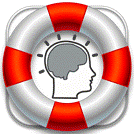1.2 to 1.7 percent (or approximately 2.3 million) of Americans over 18 and approximately 1% of children 14-18 (National Institutes of Health) experience bipolar disorder. Another 1% of the population experiences a condition called Cyclothymia. Cyclothymia’s manic and depressive episodes are less intense and shorter than that of full-blown Bipolar disorder and are referred to as “hypomania” and “dysthymia.” People with Cyclothymia often go untreated and are perceived as just having extreme and frequent mood swings. Think of it on a continuum:
Bipolar/Clinical Depression—>Dysthymia—>Nonclinical Depression—>Normal—>Elated—> Hypomanic—>Manic
Bipolar disorder often gets a bad reputation because people often lump it in with psychotic disorders like schizophrenia. The term “bipolar disorders” actually represents a cluster of mood disorders in which people alternately feel periods of “mania” and “depression” with shorter or longer periods of remission. People with Bipolar experience extremes in their mood. Their “highs” are really high and their “lows” are unbearable. A manic episode can be diagnosed when three or more of the following qualities are present at the same time:
Manic Symptoms in Adults
Inflated self-esteem or grandiosity
Decreased need for sleep (e.g., feels rested after only 3 hours of sleep)
More talkative than usual or pressure to keep talking
Flight of ideas or subjective experience that thoughts are racing
Distractibility (i.e., attention too easily drawn to unimportant or irrelevant external stimuli)
Increase in goal-directed activity (either socially, at work or school, or sexually) or psychomotor agitation
Excessive involvement in pleasurable activities that have a high potential for painful consequences (e.g., engaging in unrestrained buying sprees, sexual indiscretions, or foolish business investments)
Manic Symptoms in Children
Severe changes in mood, either extremely irritable or overly silly and elated
Overly-inflated self-esteem; grandiosity
Increased energy
Decreased need for sleep, ability to go with very little or no sleep for days without tiring
Increased talking, talks too much, too fast; changes topics too quickly; cannot be interrupted
Distractibility, attention moves constantly from one thing to the next
Hypersexuality, increased sexual thoughts, feelings, or behaviors; use of explicit sexual language
Increased goal-directed activity or physical agitation
Disregard of risk, excessive involvement in risky behaviors or activities
*Note: In children Bipolar Disorder, ADD/ADHD and Oppositional Defiant Disorder are often difficult to differentiate and misdiagnosed. Make sure to tell your doctor if treatment starts making your child’s behavior worse. Many ADD/ADHD medications can make symptoms worse if the child actually is Bipolar.
**Note: Hypomanic symptoms are the same as manic ones, but their intensity and the degree to which they disrupt a persons life is less than that of mania.
People often mistake simple mania for psychotic behavior. This is a crucial mistake. As you can see in the symptoms above, most people in a manic episode are hyper and possibly annoying, but very rarely dangerous to others. Psychosis, on the other hand is a generic term indicating that a person’s thought and perception are severely impaired sometimes referred to as a “loss of contact with reality”. During a psychotic episode, people may experience hallucinations, delusional beliefs (e.g., paranoid delusions), demonstrate personality changes and exhibit disorganized thinking. The person in a psychotic episode lacks insight into the unusual or bizarre nature of such behavior, and has difficulties with social interaction and impairments in carrying out the activities of daily living.
Again, people with psychotic disorders are often misunderstood. We center on television shows like “Criminal Minds” and think that psychosis=danger. This is rarely true. Although their behavior may be bizarre, they, like the person in the manic episode, are usually more of a threat to themselves (i.e. because they fear their food is contaminated so they won’t eat or think they are All-Powerful and antagonize the wrong person and get into a bar-room brawl). If you are dealing with someone in a psychotic episode, it is vital to remember that their reality is not yours (and may never be). Just like the child who truly believes there are monsters under his bed, it is futile to try to convince them that their hallucinations are not there or their delusions are “crazy.” Instead, help them solve what they perceive as the problem. At the very least, make them understand that you “believe” them and you will try to help them with their problem as they see it.
The depressive side of Bipolar disorder is often the most dangerous for people, and for law enforcement. Since people with Bipolar disorder experience such extremes of mood, their depression can quickly plummet to the level of suicide or suicide-by-cop.
Between 30% and 60% of people with Bipolar disorder also have a substance abuse disorder and patients with bipolar are notorious for not taking their medications. (Why? Because although the lows are really low, the highs are incredible—some would say addictive and the side effects of some medications are less than appealing.)
What does this mean for you? Well, probably more often than not the people you interact with who are substance abusers and “acting out” have a bipolar diagnosis or some other mental health diagnosis. Additionally, the medication they are taking (of failing to take) may interact with any substances they are taking which makes neither produce the anticipated effect. Finally, although they are usually not dangerous, the impulsivity and agitation inherent in a manic or hypomanic episode may lead them to make poor decisions or act “hinky” which could easily make you feel threatened. In the throes of a depressive episode, they may also intentionally act to provoke you. It is important to remember, that many—most—people with Bipolar Disorder or Cyclothymia never come into contact with the police. The persons you encounter often are the most severe. Be careful but compassionate. Bipolar disorders are very treatable, but require a combination of medication and lifestyle changes.
Bipolar Self-Assessment
http://www.blackdoginstitute.org.au/bipolar/howtotell/selftest.cfm
http://www.dbsalliance.org/questionnaire/screening_intro.asp
